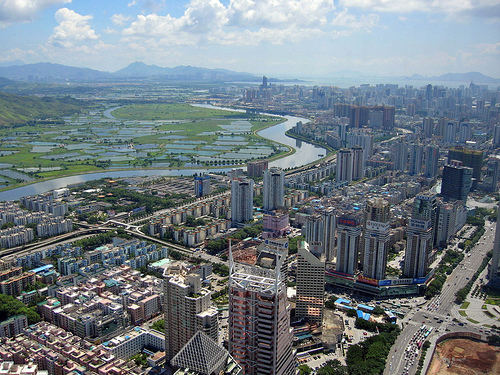Exploring Green Cities in China
+ Matthew Kahn
In this blog post, I want to give an overview of my China research during the last 7 years. For folks who find this interesting, I have a piece forthcoming in the September issue of the Journal of Economic Literature and I’m working with Siqi Zheng on a full length popular book that fleshes out all of the subjects I discuss below. I’d also encourage you to read my new Harvard Business Review piece on bullet trains.
All of the research paper I discuss here lie at the intersection of environmental, urban, energy and real estate economics. They all relate to my lifelong interest in “Green Cities” but now my focus is China. All of this work is joint with Siqi Zheng of Tsinghua University and several other great co-authors.
- We investigated the pricing of Beijing residential real estate using geocoded land sales and pre-sold apartments. Both the monocentric city model and the theory of compensating differentials help to explain the observed patterns. Access this paper.
- Following the cross-city U.S compensating differentials literature, we measure cross-Chinese city compensating differentials for pollution and climate. We also document an Environmental Kuznets Curve for China’s cities at a point in time and find that several of China’s richer cities have past the “turning point.” We document a negative correlation between city foreign direct investment inflows and pollution concentrations. This evidence goes against classic pollution havens claims. Access this paper.
- Building on Glaeser and Kahn’s (2010) study ranking the household carbon footprint of U.S cities for standardized households, this study uses high quality household micro data to rank China’s cities with respect to their household carbon footprint. Access this paper.
- This paper investigates the nascent market for “green buildings” in China. We document the need for formal certification of these buildings so that developers cannot make false claims about their building’s performance. Access this paper.
- We investigate the consequences of China’s investment in bullet trains on 2nd and 3rd tier cities that now have increased access to the mega-cities. This paper uses cross-city real estate pricing data and calculates changes in market potential brought about by the introduction of the bullet train. Access this paper.
- We study the cross-city capitalization of ambient air pollution into Chinese home prices using an instrumental variables strategy that exploits cross-geographic imports of emissions from nearby pollution sources. Such “random” variation in pollution allows for more credible compensating differentials estimates than relying on OLS estimates. We document significant heterogeneity of this capitalization as a function of the city’s income, education and hukou migration limits. Access this paper.
- We study the incentives of Chinese mayors to provide public goods for the public. The “rules of the game” are changing for these leaders and they now face stronger incentives to supply “blue skies.” Access this paper.
- We study how private sector real estate investors and restaurant chains in Beijing respond to enormous public investments in new subway lines. We find that private sector investment increases in geographic areas where the public sector has invested. These joint investments stimulate gentrification in these “treated” parts of the city. Access this paper.
Cross-posted with modifications from Environmental and Urban Economics.

